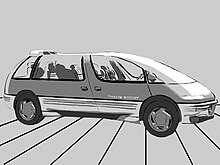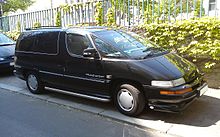Pontiac Trans Sport
| Pontiac Trans Sport | |
|---|---|
| Production period: | 1990-1999 |
| Class : | Van |
| Body versions : | Station wagon |
| Successor: | Pontiac Montana |
The Pontiac Trans Sport and its sister models Chevrolet Lumina APV and Oldsmobile Silhouette were a trio of vans from the US automobile company General Motors , which came on the market in the summer of 1990.
background
With the Trans Sport and its parallel models , General Motors wanted to compete against the successful Dodge Caravan and Plymouth Voyager models from Chrysler . Since larger van models such as the Chevrolet Astro and GMC Safari had a construction with a separate frame and rear-wheel drive, the new models with front-wheel drive and plastic body were aimed at a different market segment, but with them Chrysler's dominant position in the minivan market was achieved of the late 1990s did not affect it. The GM minivans were more successful than the Astro and Safari, but were not able to take Chrysler's market share on a large scale.
The style study
When it was presented to the public in 1986, the style study of the Pontiac Trans Sport was very well received by the public. It was shaped by many so-called "dream car" features such as futuristic styling, individually removable bucket seats with integrated stereo speakers, a wing door for the rear passengers and very generously dimensioned glass surfaces through to glass inserts in the roof.
As a result of the positive echo that the style study received, the Pontiac Trans Sport received approval for series production. But as is often the case, the design and special features of the style study could not be incorporated into the series here either. The production of the wing door would have been too costly and would also have led to problems in garages. The glass roof was too heavy and too expensive, so in the production version the pulpit was imitated with glossy black painted sheet metal panels.
In order to reach as many customers as possible, parallel models based on the Trans Sport were developed for the brands Chevrolet and Oldsmobile . The Lumina APV was the budget option, the Trans Sport was intended for the sporty, style-conscious buyer, and the Oldsmobile Silhouette was intended to be the minivan for the premium market.
Technology and innovations
In the meantime shut down General Motors -Werk Tarrytown, New York minivans built based on the so-called U-platform and had a space frame frame made of galvanized steel and a plastic body which is opposite to rust and small deformations insensitive showed up; a design that had been developed for the Pontiac Fiero and was later used by GM for various Saturn models.
The Trans Sport was available as a seven-seater, the five rear seats weighed 15 kg each and could be individually removed and arranged in different arrangements. From 1994 integrated child seats were also available as an extra.
Anyone who ordered the car with a level control package, in which the vehicle height was regulated by a compressor together with the rear gas pressure shock absorbers depending on the load, also received a compressed air connection with which tires, air mattresses and the like could be inflated.
From 1994 a sliding door with remote control was also offered, a General Motors innovation that is now also used in many other minivans.
In the 1994 and 1995 model years, traction control was available in conjunction with the 3.8 liter engine.
Modest sales success
The design of the minivan was controversial. The extremely large, long and steeply inclined windshield and the resulting long axis to the lower end of the windshield ensured that automobile magazines named the new minivans "Dustbusters" - after the Black & Decker brand for handheld vacuum cleaners, as the minivans in the side view had a profile similar to this.
The original engine for this van was a 3.1 liter V6 that developed 88 kW (120 hp). In 1992 the Trans Sport and its offshoots received the 3.8-liter 3800 V6 with 127 kW (170 hp) as an option, which produced higher torque and better acceleration. This engine made the Trans Sport the most powerful minivan with the best handling of its time.
In response to auto magazine reviews (and relatively poor sales) based on avant-garde styling, feedback from potential buyers and Chrysler advertising, the car received a facelift in 1994, with a shorter front section and a more conventional design. In addition, an edge was inserted on the inside of the windshield towards the dashboard, which should help visually reduce the perceived distance between the passengers and the window.
In Europe, where people were used to modern- looking minivans thanks to the Renault Espace , the response to the futuristic styling was more open-minded and sales grew significantly. The European version was a version of the Oldsmobile Silhouette from 1994 , which was converted to a European Pontiac Trans Sport by adding a Pontiac logo and corresponding hubcaps. Another European specialty was the range of four-cylinder engines that were more economical than the six-cylinder engines that were only sold in America. From 1993 there was a 2.3-liter four-cylinder, four-valve gasoline engine from Oldsmobile that developed 101 kW (137 hp) and was only combined with a five-speed manual transmission. In 1995 the introduction of a diesel version was planned. A 1.9 l unit with 66 kW (90 PS) from PSA was supposed to be used, but it was too weak for the vehicle and it was never sold.
The production of this generation of minivans ended when the factory in Tarrytown, where other models had been built since 1900, was shut down in 1996.
The second generation was offered in Europe under the Chevrolet brand.
Trans Sport (1990-1996)
| 1st generation | |
|---|---|
|
Pontiac Trans Sport (1990-1993) |
|
| Production period: | 1990-1996 |
| Body versions : | Station wagon |
| Engines: |
Petrol engines : 2.3–3.8 liters Diesel: 1.9 liters |
| Length: | 4940-4945 mm |
| Width: | 1895 mm |
| Height: | 1650-1669 mm |
| Wheelbase : | 2789 mm |
| Empty weight : | 1630-1770 kg |
1990
- Launch in August
- Available as Trans Sport (with, regardless of the paint color, silver-gray planking) and as Trans Sport SE (monochrome)
- Delivery of the Oldsmobile Silhouette in Europe as Pontiac Trans Sport (distribution through selected Opel dealers), with small differences in the design, engine, transmission and lighting
1991
- Customer complaints about reflections on the windshield, so the plastic was replaced with black felt
- Electric windows and central locking in the USA series
1992
- A 3.8-liter V6 engine with electronic four-speed automatic transmission with overdrive (Hydramatic type 4T60E) is now available
- New Trans Sport GT model with a 3.8-liter V6 engine as standard
- Elimination of the basic model, only the "SE" and "GT" models are offered
- No silver-gray planking
- Leather seats available for an extra charge in the "GT", previously only in the Oldsmobile Silhouette
- The antenna on the hood is replaced by an integrated roof antenna (in a film between the roof and the sky)
- Larger, foldable rearview mirror
- Stronger brakes, ABS as standard
- Glass lifting roof as a new extra
- Radio remote control buttons on the steering wheel available at an additional cost
1993
- GT version is omitted, the equipment of the GT can be ordered individually as extras. All Trans Sport models from 1993 to 1996 were called Trans Sport SE
- A sliding door that can be operated with a remote control is announced for 1993, but is actually not yet available for that model year
- New color variant with gold-colored plastic planks on the body, gold-colored painted rims and a roof in body color from the C-pillar, available for an extra charge in conjunction with individual paint colors
- Redesigned center console with larger levers for regulating the air conditioning, a small storage compartment and a large shelf at the foot of the console
1994
- Facelift in January with a front section 8 cm shorter, headlights like the Pontiac Bonneville , fog lights below the bumper as standard and less conspicuous plastic planks
- To reduce the perceived distance from the underside of the windshield, an edge was added to the dashboard
- The remote-controlled sliding door is available
- Integrated child seats for the second row of seats are available
- Traction control available for an extra charge
- The dark tinted rear windows in a darker tint
- Driver airbag now standard
1995
- Automatic door locking and unlocking when engaging or leaving the "P" position for the automatic transmission as part of the central locking package, which is subject to a surcharge
- The rear part of the roof (from the C-pillar) now basically in the body color, previously painted as standard in black or in the body color at no extra cost - another attempt to adapt the car to the style of conventional vans
1996
- The 3.1 and 3.8 liter V6 engines are omitted and replaced by a 3.4 liter V6
- No more traction control available
Trans Sport (1996-1999)
| Second generation | |
|---|---|
|
Pontiac Trans Sport (1996-1999) |
|
| Production period: | 1996-1999 |
| Body versions : | Station wagon |
| Engines: |
Otto engine : 3.4 liters |
| Length: | 4757-5113 mm |
| Width: | 1847 mm |
| Height: | 1712-1730 mm |
| Wheelbase : | 2845-3048 mm |
| Empty weight : | 1630-1770 kg |
In August 1996 there was a model change at Trans Sport and its parallel models. The goal was a more conventional and conventionally styled minivan. The plastic trim, sleek styling, and spaceship-like appearance disappeared, making these models very similar to their former competitors Chrysler Voyager and Ford Windstar .
With the start of production of the new generation, Pontiac offered a Montana options package with a special fairing and wheel equipment that gave the model an SUV-like appearance.
Production for this generation took place at GM's Doraville, Georgia facility .
Engine:
Name change
From autumn 1999 (in Canada from spring 2000) the name Trans Sport was dropped in favor of the model name Montana, as over 80% of all Trans Sport models had been sold in the Montana variant.
- See: Pontiac Montana
European market
This version of the Pontiac Trans Sport was sold as Opel / Vauxhall Sintra from the second generation (1996) and after its end of sale in 1999 as Chevrolet Trans Sport. Unlike the Sintra, which was based on the Pontiac Trans Sport , Pontiac Montana , Chevrolet Venture , Oldsmobile Silhouette and the earlier generation of the Buick GL8 (for the Chinese market), the Chevrolet was absolutely identical to the Pontiac except for the logo.
The European van had different front, side and rear sections and also differed in the lighting units, seat belts and safety equipment. The vehicles were particularly successful in Sweden. In Europe, a version with a 2.3-liter 4-cylinder 16V engine with 108 kW (147 PS), built in 1993–1997 (or 101 kW (137 PS), built in 1992/1993) was offered . This engine was only supplied with a manual 5-speed gearbox.
Security criticism
A crash test video of the Trans Sport / Montana built between 1997 and 2004 resulted in massive criticism of the safety of the car:
- the extreme deformation of the roof left little room for the driver to survive
- extreme movement of the steering wheel jerked the dummy head backwards
- The unnatural position of the left foot on the dummy showed that the driver's left leg was seriously injured in a crash.
- The forces on the lower left leg were so strong that the metal foot of the dummy broke off at the ankle.





